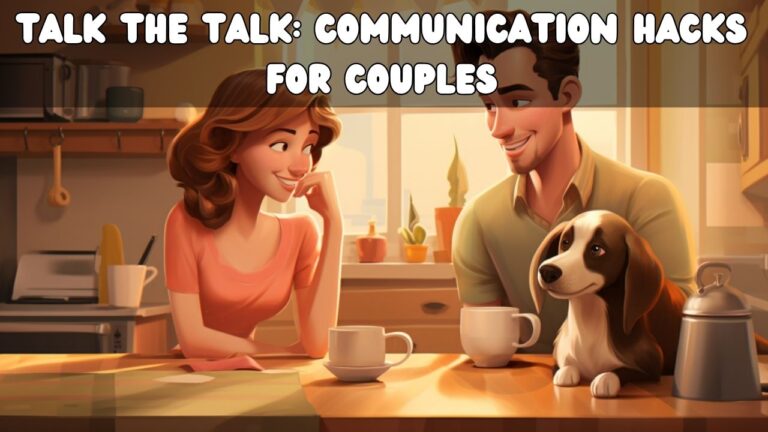
Relationships, in their myriad forms and stages, often resemble intricate dance routines. Partners move in synchrony, sometimes leading, at other times following, but always aiming for harmony. At the heart of this dance lies the magic of communication. It’s the rhythm that keeps the dance flowing, the notes that prevent partners from stepping on each other’s toes. As we venture into this exploration of relationship communication, we’ll uncover the subtleties and techniques that can elevate this dance to a waltz of understanding and intimacy.
Communication is more than just a mere exchange of words. It’s an art, a continuous process of sending and receiving messages, both verbal and non-verbal. In relationships, effective communication is akin to the foundation of a house. A strong foundation ensures the house stands tall and firm against the challenges of time and weather. Similarly, a relationship grounded in open, honest, and effective communication can weather the storms of misunderstandings, conflicts, and external pressures.
As we embark on this journey, we will delve into the intricacies of active listening, the power of expressing feelings with clarity, and the art of resolving conflicts constructively. We’ll also explore the importance of maintaining an open dialogue, understanding the silent cues in non-verbal communication, and the transformative effect of asking the right questions. This exploration is not just theoretical; it’s a toolkit, packed with practical insights and actionable tips to elevate your relationship communication to new heights.

In a world inundated with noise, genuine listening has become a rare commodity. Especially in relationships, where words hold profound emotions and intentions, merely hearing is not enough. Active listening, an intentional and focused form of listening, can elevate a conversation from a mere exchange of words to a meaningful and deep connection.
Active listening is a two-fold process. First, it involves fully concentrating on what’s being said rather than just passively ‘hearing’ the message. Secondly, it encompasses understanding, responding, and then remembering the main points. It’s a conscious effort to be present, showing genuine interest in understanding the speaker.
In relationships, its importance is paramount. Active listening bridges the emotional gap, helping partners feel valued and heard. It’s not just about comprehension but also about empathy. By listening actively, we signal to our partners that their thoughts, feelings, and concerns matter deeply to us.
Mastering active listening is a continuous journey, but here are a few techniques to set you on the right path:
Active listening is more than just a communication technique; it’s a relationship enhancer. Here’s how:
In the dance of relationships, active listening is akin to maintaining the rhythm. It ensures that neither partner misses a step, creating a harmonious duet of mutual understanding and respect.

Relationships often find themselves on shaky ground, not because of the absence of feelings, but because of the ambiguity in expressing them. When it comes to sharing emotions, clarity can be the difference between forging stronger bonds and unintended misunderstandings. Precision in articulating feelings doesn’t minimize their intensity but rather amplifies their authenticity.
Emotions are raw, unfiltered reactions to experiences and thoughts. They’re the raw materials of our inner world – joy, anger, love, jealousy, excitement, and a myriad of others. However, how we choose to communicate these emotions is expression. While we might not always have control over our emotions, we have agency over our expressions.
Consider a situation where you feel neglected because your partner often comes home late from work. The emotion is feeling neglected or unimportant. However, there are several ways you could express it:
The latter doesn’t diminish the feeling but presents it in a way that’s less accusatory and more open to understanding.
“I” statements are a transformative tool in the realm of relationship communication. Instead of starting sentences with “You,” which can come off as blaming, begin with “I,” which emphasizes your feelings and perceptions.
For instance, instead of saying, “You never listen to me,” try, “I feel unheard when we discuss important topics.” This subtle shift focuses on expressing the emotion rather than accusing, paving the way for empathy and constructive conversation.
In essence, the clarity in expressing feelings is a gift – not just to your partner but also to yourself. It unburdens the heart, fosters understanding, and strengthens the relational tapestry between couples.

Every relationship, no matter how harmonious, is bound to encounter disagreements. These moments of discord can either act as wedges, driving couples apart, or as catalysts, fostering growth, understanding, and intimacy. The difference lies in how couples approach, navigate, and resolve these conflicts. Approaching disagreements as opportunities rather than threats can redefine the very fabric of a relationship.
Conflicts, at their core, are a manifestation of differences – in opinions, values, desires, or perspectives. Such differences are inevitable given that each individual brings their unique set of experiences, beliefs, and vulnerabilities into a relationship.
It’s essential to understand that disagreements, in and of themselves, are not detrimental. In fact, they’re natural and can even be beneficial. They shine a light on areas that need attention, provide opportunities for growth, and can deepen mutual understanding. The real challenge, and where the potential harm lies, is in how these disagreements are managed.
Certain behaviors can escalate conflicts or prevent their resolution. Being aware of and avoiding these can pave the way for more constructive outcomes:
In conclusion, while conflicts are an inevitable facet of relationships, they don’t need to be destructive. With understanding, empathy, and constructive strategies, couples can navigate disagreements in ways that foster growth, trust, and deeper intimacy.

A relationship, much like a blossoming plant, thrives in an environment where it’s tended to with care, honesty, and openness. The courage to be transparent and vulnerable, to share both our joys and fears, creates a foundation of trust that becomes the bedrock of lasting relationships. However, cultivating such an environment requires conscious effort, intent, and mutual respect.
Trust, the cornerstone of any relationship, is built brick by brick, moment by moment. It flourishes in an environment where both partners feel that they can share their truths without judgment or fear.
Being transparent isn’t just about confessing mistakes or sharing secrets. It’s about letting your partner in on your thoughts, your aspirations, your fears, and even those mundane moments of your day. This consistent and full-hearted sharing fosters a deeper understanding, reinforcing the bond.
Moreover, when partners witness and honor each other’s transparency, it creates a positive feedback loop. They become more likely to share in the future, knowing they’ll be met with understanding.
Creating a conducive environment for open dialogue is as important as the dialogue itself. Here’s how you can build that safe space:
Life, with its myriad distractions and challenges, can sometimes create inadvertent distance between couples. To counteract this drift, periodic relationship check-ins can be invaluable.
These scheduled talks, which can be weekly, monthly, or whatever frequency works for the couple, are dedicated times to discuss the relationship itself. It’s an opportunity to share feelings, address concerns, celebrate successes, and set mutual goals. These sessions aren’t just for addressing problems; they’re also for acknowledging growth, appreciating each other, and strengthening the connection.
Having a regular schedule ensures that both partners prioritize this essential dialogue, making it a foundational practice in their relationship.

While spoken words play an integral role in relationships, much of human communication happens beyond them. In fact, a significant chunk of our emotional exchanges with our partners, or any individual for that matter, takes place non-verbally. The nuances of body language, touch, and eye contact can communicate sentiments that words often fall short of conveying. By honing in on these non-verbal cues, couples can foster deeper understanding and intimacy.
Body language offers a wealth of information about a person’s feelings, thoughts, and intentions. A slight change in posture, a fold of the arms, or even the tilt of the head can speak volumes.
Touch, one of the most primal forms of communication, holds immense power in connecting human souls. Whether it’s a simple hand-hold, a comforting hug, or a gentle caress, these actions often communicate love, care, and support more effectively than words.
Our eyes, often termed the ‘windows to the soul,’ are powerful communicators. A single look can convey myriad emotions, from love and adoration to pain and regret.

Communication isn’t just about expressing oneself; it’s equally, if not more, about inviting others to share their worlds with us. By asking meaningful questions, couples can delve deeper into each other’s minds and hearts, nurturing understanding and intimacy. This process not only reaffirms the bond but also offers fresh insights into each other’s evolving perspectives, dreams, fears, and aspirations.
Effective questioning isn’t about interrogating or prying, but rather about creating an atmosphere where both partners feel safe, valued, and curious to explore.
Understanding the difference between these types of questions can greatly influence the depth and direction of a conversation.
To continue growing together, couples can periodically venture into deeper territories with questions that encourage vulnerability and dreams-sharing.

In the cacophony of modern life, where rapid-fire exchanges are often the norm, the value of pauses and silence in conversations cannot be understated. Whether it’s the quiet that envelops after a profound revelation or the moments taken to process challenging news, these silent intervals can hold deep significance in relationship communications. Let’s explore how embracing and understanding this unsaid power can transform conversations between couples.
Silence is often misconstrued as a void, but in the realm of relationships, it can be a powerful communicator. Silence can be reflective, respectful, or even revolutionary.
Well-timed pauses are not merely conversational fillers. They can be strategically used to deepen understanding and encourage empathy.
While strategic silence has its merits, it’s essential to distinguish between constructive pauses and prolonged, awkward silences that might stem from uncertainty, discomfort, or even passive aggression.

Navigating the ebbs and flows of any relationship necessitates more than just an understanding of each other’s likes and dislikes. It’s the profound connection, established and nurtured through effective communication, that truly forms the bedrock of lasting relationships. As we close this exploration on effective communication hacks for couples, it’s essential to encapsulate the shared wisdom and emphasize the continual journey of communication growth.
Throughout this piece, we’ve embarked on a holistic journey, understanding that successful communication is not just about talking, but also about listening, understanding, and expressing:
Communication, like any skill, requires persistent practice and evolution. As relationships grow and evolve, so do the complexities and nuances of communication within them. It’s essential to approach this aspect of relationships as a lifelong journey, one that will have its highs and lows but promises immense growth, understanding, and intimacy. With every conversation, every pause, every question, and every expression, couples can either drift apart or weave their narratives tighter.
Never underestimate the power of effective communication. As Dr. Hart would affirm, it’s the compass that navigates relationships through calm and stormy waters alike, guiding them towards a horizon of mutual understanding, respect, and love.
Dr. Seraphina Hart, PhD, is a relationship therapist with over two decades of experience in the field of psychology and human behavior. With a rich academic background from Stanford University, she has an in-depth understanding of the complexities of interpersonal relationships. Dr. Hart's journey began with a deep fascination with the human mind and how it forms emotional connections, leading her to specialize in relationship therapy.
Her compassionate approach and unique methodology are informed by her extensive study of various therapeutic modalities, including Cognitive Behavioral Therapy (CBT), Emotionally Focused Therapy (EFT), and mindfulness techniques. Dr. Hart believes in the power of empathy and understanding in healing and transforming relationships. With her guidance, clients learn to navigate their emotions, communicate effectively, and foster a deep sense of self-awareness.